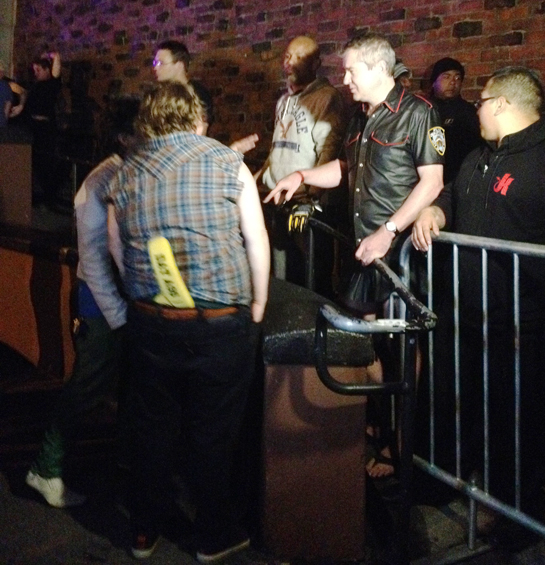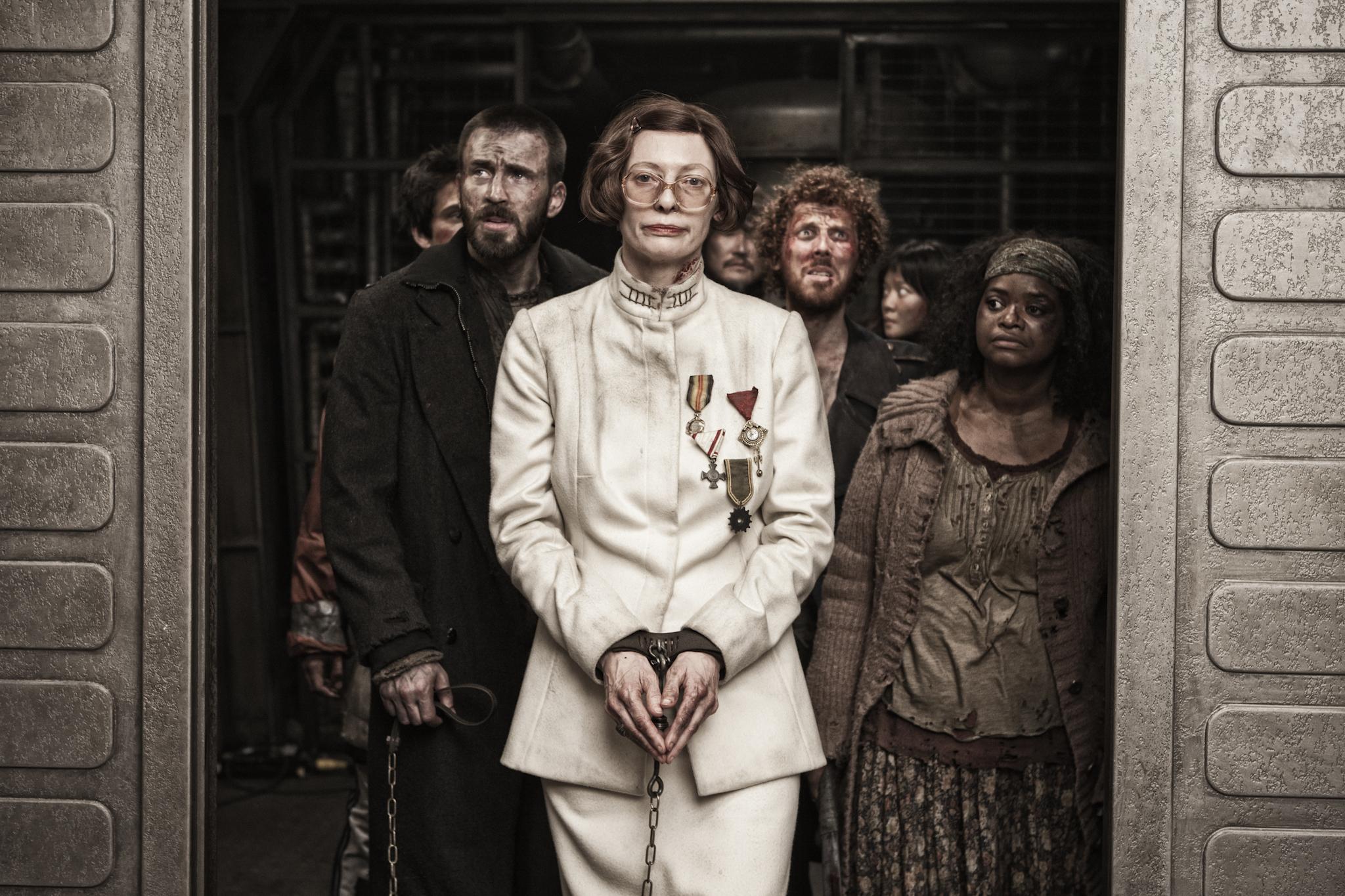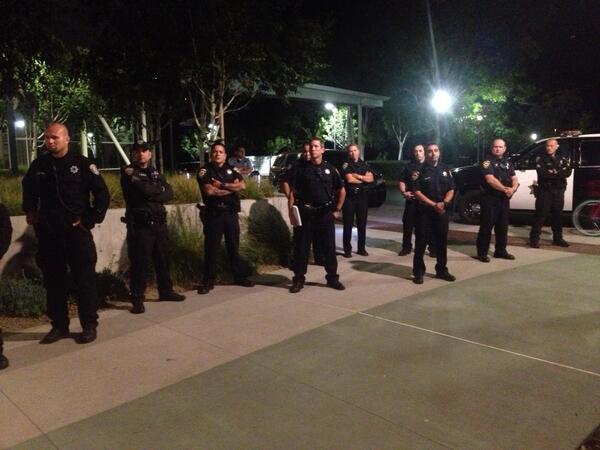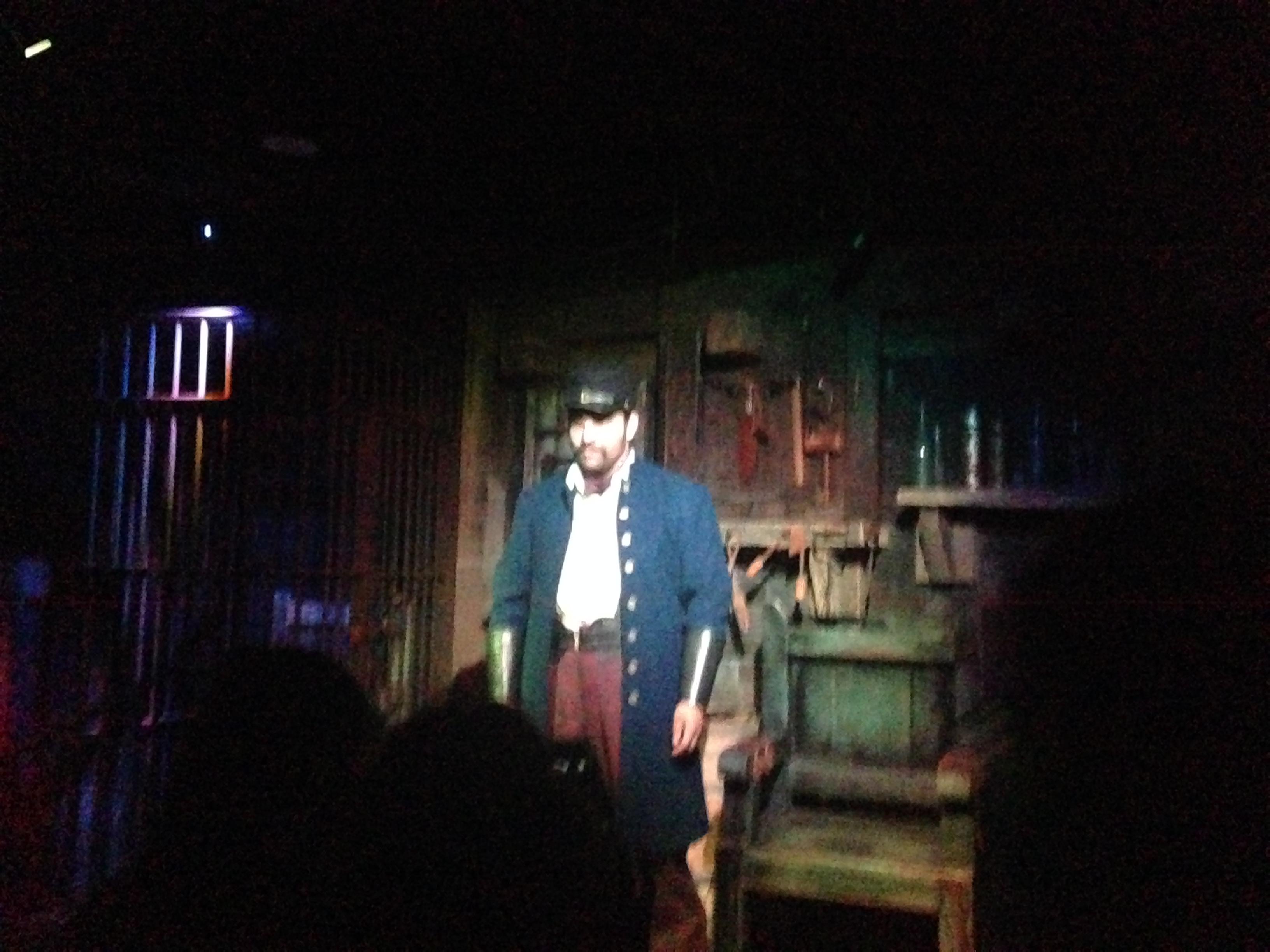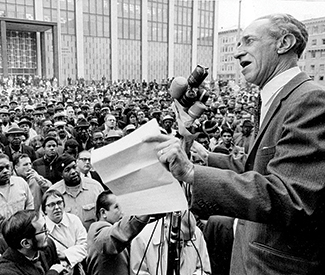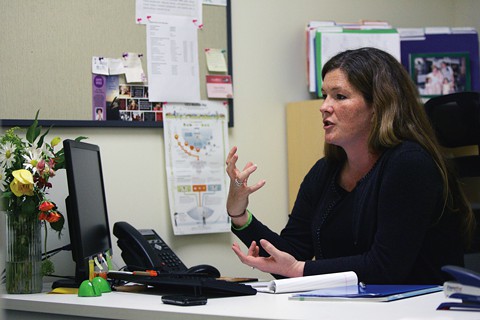Film listings are edited by Cheryl Eddy. Reviewers are Kimberly Chun, Dennis Harvey, Lynn Rapoport, and Sara Maria Vizcarrondo. For rep house showtimes, see Rep Clock.
DOCFEST
The 13th San Francisco Documentary Film Festival runs through June 19 at the Brava Theater, 2781 York, SF; Roxie Theater, 3117 16th St, SF; and Oakland School of the Arts Theater, 530 19th St, Oakl. For tickets (most shows $12) and complete schedule, visit www.sfindie.com.
OPENING
Alone Yet Not Alone Remember that Christian historical drama that was Oscar-nominated for Best Song but then got kicked out of the running because of the songwriter’s sketchy campaign tactics? No? Well, here ’tis. (1:43)
Gore Vidal: The United States of Amnesia Nicholas Wrathall’s highly entertaining documentary pays tribute to one of the 20th century’s most brilliant, original, and cranky thinkers, with extensive input from the man himself before his death in 2012 at age 86. The emphasis here is less on Vidal’s life as a literary lion and often glittering celebrity social life than on his parallel career as a harsh scold of US social injustices and political corruption. (Needless to say, recent history only sharpened his tongue in that department, with George W. Bush dismissed as “a goddamn fool,” and earlier statements such as “This is a country of the rich, for the rich and by the rich” seeming more apt than ever.) He’s a wellspring of wisdoms both blunt and witty, sometimes surprising, as in his hindsight doubts about the virtues of JFK (a personal friend) as a president. We get plenty of colorful archival clips in which he’s seen verbally jousting with such famous foes as William F. Buckley and Norman Mailer, invariably reducing them to stammering fury while remaining exasperatingly unruffled. His “out” homosexuality and outré views on sexuality in general (at odds with an increasingly assimilationist gay community) kept him controversial even among many liberals, while conservatives were further irked by his rock-solid family connections to the ruling elite. In our era of scripted political rhetoric and pandering anti-intellectualism, it’s a joy merely to spend an hour and half in the company of someone so brilliantly articulate on seemingly any topic — but particularly on the perpetually self-mythologizing, money-worshipping state of our Union. (1:29) Opera Plaza, Shattuck. (Harvey)
How to Train Your Dragon 2 Sequel to the 2010 animated hit about Vikings and their dragon buddies, with voices by Jay Baruchel, Cate Blanchett, Gerard Butler, Djimon Honsou, America Ferrera, Kit Harington, Jonah Hill, and others. (1:42) Four Star, Presidio.
Obvious Child We first encounter the protagonist of writer-director Gillian Robespierre’s funny, original film — a Brooklyn-dwelling twentysomething named Donna (Jenny Slate), who works at a lefty secondhand bookstore and makes regular (if unpaid) appearances at a local comedy night — onstage mining such underdiscussed topics as the effects of vaginal discharge on your garden-variety pair of underwear. This proves a natural segue to other hefty nuggets of embarrassment gold concerning her love life, to the dismay of boyfriend Ryan (Paul Briganti), auditing from the back of the club. He pretty much deserves it, however, for what he’s about to do, which is break up with her in a nasty, well-populated unisex bathroom, taking time to repeatedly glance at the texts coming through on his phone from Donna’s good friend, with whom he’s sleeping. So when Donna, mid-drowning of sorrows, meets a nice-looking fellow named Max (Jake Lacy) at the bar, his post-fraternity-presidency aesthetic seems unlikely to deter her from a one-night stand. The ensuing trashed make-out dance-off in Max’s apartment to the Paul Simon song of the title is both comic and adorable. The fractured recap of the evening’s condom-free horizontal events that occurs inside Donna’s brain three weeks later, as she hunkers down with her best friend, Nellie (Gaby Hoffmann), in the bookstore’s bathroom after peeing on a stick, is equally hilarious — and unwanted-pregnancy jokes aren’t that easy to pull off. Robespierre’s treatment of this extended windup and of Donna’s decision to have an abortion is a witty, warmhearted retort to 2007’s Knocked Up, a couple generations’ worth of Hollywood rom-com writers, and an entertainment industry that continues to perform its sweaty contortions of storytelling in the gutless cause of avoiding the A-word. (1:15) Embarcadero. (Rapoport)
The Signal Sharing its title with a 2007 film — also a thriller about a mysterious transmission that wreaks havoc in the lives of its protagonists — this offbeat feature from co-writer and director William Eubank belies its creator’s deep affection for, and knowledge of, the sci-fi genre. Number one thing The Signal is not is predictable, but its twists feel organic even as the story takes one hairpin turn after another. MIT buddies Nic (Brenton Thwaites) and Jonah (Beau Knapp) are driving Nic’s girlfriend, Haley (Olivia Cooke), cross-country to California. Complicating the drama of the young couple’s imminent separation is Nic’s deteriorating physical condition (it’s never explained, but the former runner apparently has MS or some other neurological disease). The road trip turns dark when the trio (who also happen to be hackers) realize an Internet troll they’ve tangled with in the past is stalking them. After a brief detour into found-footage horror — fooled ya, Eubank seems to be saying; this ain’t that kind of movie at all! — the kids find themselves embroiled in ever-more-terrifying realities. To give away more would ruin the fun of being shocked for yourself, but think Twilight Zone meets Area 51 meets a certain futuristic trilogy starring Laurence Fishburne, who turns up here to play a very important role in Nic and company’s waking nightmare. (1:37) California. (Eddy)
Supermensch: The Legend of Shep Gordon See “Puff Piece.” (1:24) Embarcadero.
22 Jump Street Comedy cops Jonah Hill and Channing Tatum return for more undercover sleuthing in a slightly more age-appropriate milieu: college. (1:45) Marina, Shattuck.
ONGOING
The Amazing Spider-Man 2 The best thing about The Amazing Spider-Man 2 — the sequel to the 2012 reboot that nobody really wanted in the first place — is the achingly cute chemistry between real-life couple Andrew Garfield (Peter Parker/Spider-Man) and Emma Stone (Gwen Stacy, whose fate is no spoiler to anyone who is familiar with the Spider-Man canon). Can’t deny it; those two are adorbs. But since Spider-Man is supposed to be an action movie, not a romantic comedy, it spends most of its time setting up foes for the webslinger (Jamie Foxx as a nerd zapped into the power-mad Electro; Dane DeHaan as bratty rich kid Harry Osborn), as well as rehashing the mysterious deaths of Peter’s parents, and underlining for approximately the zillionth time the disconnect between the media’s perception of Spider-Man (he’s a menace! He interferes with police work!) and the ecstatic love the people of New York have for the guy — understandable, since he’s in the business of saving their butts on a regular basis. This isn’t a crappy movie by any means; it’s entertaining enough, and the 3D swooping-between-skyscrapers FX have gotten quite dazzling. But there’s still a heavy air of “This again?” that hangs over the whole thing. Doesn’t Marvel have enough dough from the Avengers movies to let Spidey take an extended vacation? (2:20) Metreon. (Eddy)
Belle The child of a British naval officer and a Caribbean slave, Belle (Gugu Mbatha-Raw) is deposited on the doorstep — well, the estate grounds — of her father’s relatives in 1769 England after her mother dies. Soon she’s entirely orphaned, which makes her a wealthy heiress and aristocratic title holder at the same time that she is something less than human in the eyes of her adopted society. For Belle is black (or more properly, mixed-race), and thus a useless curiosity at best as a well-bred noblewoman of the “wrong” racial makeup. Based on a murky actual historical chapter, Amma Asante’s film is that rare sumptuous costume drama which actually has something on its mind beyond romance and royalty. Not least among its pleasures are a fine supporting cast including Tom Wilkinson, Miranda Richardson, Penelope Wilton, and Emily Watson. (1:45) Embarcadero, Piedmont, Shattuck. (Harvey)
Blended (1:57) SF Center.
Captain America: The Winter Soldier Marvel’s most wholesome hero returns in this latest film in the Avengers series, and while it doesn’t deviate from the expected formula (it’s not a spoiler to say that yes, the world is saved yet again), it manages to incorporate a surprisingly timely plot about the dangers of government surveillance. Steve Rogers (Chris Evans), hunkiest 95-year-old ever, is still figuring out his place in the 21st century after his post-World War II deep freeze. Nick Fury (Samuel L. Jackson) has him running random rescue missions with the help of Black Widow (Scarlett Johansson), but SHIELD is working on a top-secret project that will allow it to predict crimes before they occur. It isn’t long before Cap’s distrust of the weapon — he may be old-fashioned, but he ain’t stupid — uncovers a sinister plot led by a familiar enemy, with Steve’s former BFF Bucky doing its bidding as the science-experiment-turned-assassin Winter Soldier (Sebastian Stan). Anthony Mackie, Robert Redford, and series regular Cobie Smulders are fine in supporting roles, and Johansson finally gets more to do than punch and pose, but the likable Evans ably carries the movie — he may not have the charisma of Robert Downey Jr., but he brings wit and depth to a role that would otherwise be defined mainly by biceps and CG-heavy fights. Oh, and you know the drill by now: superfans will want to stick around for two additional scenes tucked into the end credits. (2:16) Metreon. (Eddy)
Chef Not to take anything away from the superhero crew, but Chef feels like the closest thing to a labor of love from writer, director, and star Jon Favreau in many a day. As a director, he may have been making doughnuts — fun-filled and teeming with CGI eye candy, but doughnuts nevertheless — when it came to effects-driven blockbusters like 2008’s Iron Man, but this well-meaning play for the heart, by way of the stomach, shows you where Favreau’s head is really at. Chef revolves around Carl Casper (Favreau), a onetime food star, now reduced to serving up predictable crowd-pleasers at the behest of his restaurant’s overbearing owner (Dustin Huffman). It takes the barbs of an influential critic (Oliver Platt) — and an ensuing Twitter war — to set Carl off and send him away on his own, at the coaxing of his glam ex Inez (Sofia Vergara). Hooked up with a dilapidated food truck and former kitchen staffer Martin (John Leguizamo), and aided by ably Tweeting son Percy (Emjay Anthony), Carl ties his dreams — and lost passion — to the classic Cuban sandwich. The ensuing road trip from Miami to LA, and Carl’s journey toward self and a renewed relationship with his son, is a fun (if, in the end, a bit too speedily sketched) vault through the joys of eating your way through America’s new culinary heartland. Amid the volley of sign-of-the-times social-media swinging and cameos by the uncostumed Robert Downey Jr., Scarlett Johansson, and the like, Favreau’s main dish is that a family that eats, cooks, and runs a business together, stays together — child labor laws or no. (1:55) 1000 Van Ness, Metreon, Presidio, Sundance Kabuki. (Chun)
The Dance of Reality His unique vision recently re-introduced to audiences by unmaking-of documentary Jodorowsky’s Dune, cinematic fabulist Alejandro Jodorowsky is back with his first film in a quarter-century. This autobiographical fantasia shows all initial signs of being a welcome yet somewhat redundant retread of his cult-famed early work (1970’s El Topo, 1973’s The Holy Mountain), as Santa Sangre was in 1989. It starts with the filmmaker himself fulminating wisdoms about the spiritual emptiness of a money-centric world, then appearing as guardian angel to his child self (Jeremias Herskovits). Little Alejandro is raised by a bullying, hyper macho father (Brontis Jodorowsky) and warm, indulgent mother (soprano Pamela Flores, singing every line of dialogue) who naturally clash at every turn. Jodorowsky’s stunning eye for bizarre imagery (abetted by DP Jean-Marie Dreujou’s handsome compositions) hasn’t faded, so there are delights to be had even in what fans might consider an over-familiar parade of dwarfs, amputees, anti clerical burlesques (like a dress-up dog beauty contest at church), Chaplinesque circus sentimentality, and other simple if surreal illustrations of society’s eternal victims and overlords. At a certain point, however, the misdeeds of father Jaime force his self-exile. The film’s consequent picaresque allegory of epic suffering toward redemption becomes cheerfully goofy, its symbol-strewn path increasingly funny and sweet rather than burdened by import. A large part of that appeal is due to junior Jodorowsky Brontis, who demonstrates considerable farcical esprit while flashing more full-frontal nudity than Michael Fassbender and Ewan McGregor combined ever dreamed of obliging. Shot in the family’s native Chile on a purported crowd funded budget of $3 million — could Hollywood provide so much original spectacle for 30 times that amount?—The Dance of Reality finds its 84-year-old maker as frisky as a pony, one that provides an endearingly unpredictable ride. (2:10) California, Opera Plaza. (Harvey)
Edge of Tomorrow Is it OK to root for Tom Cruise again? (The Oprah thing was almost a decade ago, after all.) The entertaining Edge of Tomorrow, crisply directed by Bourne series vet Doug Liman, takes what’s most irritating about Cruise’s persona (he’s so goddamn earnest) and uses it to great advantage, casting him as military PR guru Cage — repping our armed forces on talk shows amid battles with alien invaders dubbed “Mimics” — whose oiliness masks the fact that he’s terrified of actual combat. When he’s forced to fight by a no-nonsense superior (Brendan Gleeson), he’s gruesomely killed, along with nearly every other human soldier. But wait! Thanks to a particularly close encounter with outer-space pixie dust, he awakens, unharmed, to re-live the day, over and over again (yep, shades of a certain Bill Murray comedy classic). Each “reset” offers Cage a chance to work his way closer to changing the course of the war in humanity’s favor, with key help from a badass (Emily Blunt) whose heroics on the battlefield have earned her the nickname “Full Metal Bitch.” Nothing groundbreaking here — but Edge of Tomorrow manages to make its satisfying plot as important as its 3D explosions, which means it automatically rises above what passes for popcorn fun these days. (1:53) Four Star, Metreon, 1000 Van Ness, Presidio, Sundance Kabuki. (Eddy)
Fading Gigolo Ah, the charm of a well-aged, seasoned perv &ldots; nope, we don’t dare touch the Woody Allen/Dylan Farrow abuse allegations — though those recent headlines flit around the edges of this generally benevolent, almost strangely innocuous charmer, written by and directed John Turturro, who also stars as the curiously blank-faced tabula rasa of a title character. The delights of Mrs. Robinsons have been rhapsodized on film, through the lens of worshipful younger men — less so, their male counterparts, as viewed by other hetero men. The danger of bromance surging into the homoerotic is likely too dire for most, yet somehow bookstore boss Murray (Allen) sees the mysterious, submerged sex appeal in his loyal employee Fioravante (Turturro) and taps him to get involved in a ménage à trois with a society dermatologist (Sharon Stone). The soft-spoken Fioravante turns out to be a smash in the sack with the doc, transforming the opportunistic Murray into a wildly successful pimp as his employee takes on the audacious Selima (Sofia Vergara) and the prim Jewish Orthodox widow Avigal (Vanessa Paradis). The latter character seems to have come straight from another place and time — much like this film, which turns Brooklyn into a something resembling a leaf-strewn European village and recalls odes to revolutionary sexuality in the ’60s. The movie’s lightly absurd comedy is embedded in the fact that Turturro writes himself into the role of the seducer, the pleaser, while wrapped in the skin of pleasant if everyday-looking Joe, although Paradis, a revelation as a deeply repressed devout mother slowly awakening to her body, points to more serious pleasures, lingering below the surface of all of us. (1:30) Opera Plaza. (Chun)
The Fault in Our Stars I confess: I’m no card-carrying, vlog-flogging Nerdfighter in author John Green’s teen-geek army. But one can admire the passion — and teary romanticism — of the writer, readers, and the breakthrough novel that started it all. Much has been made over the cinematic tweaks to the best-selling YA book, but those seem like small beefs: OK, male romantic lead Gus’s (Ansel Elgort) perhaps-understandable brattiness seems to have been toned down a touch, but we’ll all get the somewhat-subversive push and pull of Green’s love story centered on two cancer-stricken innocents. Sixteen-year-old Hazel (a radiant Shailene Woodley) has been battling cancer almost all her life, fighting back from the brink, and now making her way every day with an oxygen tank and her devoted parents (Laura Dern, Sam Trammel) by her side. Her mordant wit, skeptical attitude, and smarts attract Gus, a handsome teen with a prosthetic leg, at a cancer support group, and the two embark on what seems like the most normal thing in the world — sweet, sweet love — albeit cut with the poignancy of almost-certain doom. Would the girl who calls herself a grenade dare to care for someone she will likely hurt? That’s the real question on her mind when the two reach out to the solitary author (Willem Dafoe) of their favorite book, An Imperial Affliction. The journey the two make leaves them both open to more hurt than either ever imagined, and though a good part of Fault‘s denouement boils down to a major puddle cuddle — with solid performances by all, but particularly Dern and Woodley — even a cynic is likely to get a bit misty as the kids endure all the stages of loss. And learning. (2:05) Marina, 1000 Van Ness, SF Center, Sundance Kabuki. (Chun)
Fed Up Katie Couric narrates, produces, and brings celebrity heft to Stephanie Soechtig’s well-crafted expose on the alarmingly powerful food industry — specifically, revealing how “nutritional standards” put forth by the government over the past 30 years have actually caused the nation’s current obesity epidemic. Fed Up‘s straightforward combination of simple facts (80 percent of food items have added sugar); talking-head experts (Bill Clinton, UCSF’s Dr. Robert Lustig); historical fact-finding (including a segment that convincingly compares today’s food industry to the tobacco industry of yore); and profiles of dangerously overweight teens (all of whom are trying, and failing, to lose weight) adds up to a film that is poised to have An Inconvenient Truth-style impact on viewers — and will hopefully
open enough eyes to make waves beyond movie theaters. (1:32) California, Embarcadero. (Eddy)
Godzilla Bearing the weight of a 1998 American debut so stinky that devotees of the Japanese original dubbed it “GINO” (for “Godzilla in Name Only”), the King of the Monsters returns for a do-over that smells more like generic summer entertainment than anything else. We begin in 1999, when a pair of scientists (Ken Watanabe and Sally Hawkins) discover a giant skeleton of sorts in the Philippines — just as a deadly accident (or was it?) devastates a Japanese nuclear power plant. Fifteen years later, the scientists are still on the trail of Whatever That Was, while guilty power-plant survivor Bryan Cranston has become a greasy-haired conspiracy theorist, much to the annoyance of his San Francisco-based Navy officer son (Aaron Taylor-Johnson). The humans in Gareth Edwards’ film don’t actually matter much; aside from Cranston and to a much lesser extent Watanabe, none of the characters are interesting or memorable, and the plot — which has Big G lumbering after a pair of “Massive Unidentified Terrestrial Organisms” who decide to incubate their eggs in downtown SF — is also a low-stakes affair. (If you believe for a second that Taylor-Johnson’s doe-eyed wife and son won’t survive the monster attack, I have a busted-up Golden Gate Bridge to sell you.) But the monster design is plenty satisfying, and really, it’s just fine that Godzilla — who wrinkles his snout in annoyance at those pesky MUTOs — is this film’s one and only charismatic presence; dude’s going on a 70-year career at this point. (2:03) Metreon, 1000 Van Ness, Sundance Kabuki. (Eddy)
The Grand Budapest Hotel Is this the first Wes Anderson movie to feature a shootout? It’s definitely the first Anderson flick to include a severed head. That’s not to say The Grand Budapest Hotel, “inspired by” the works of Austrian novelist Stefan Zweig, represents too much of a shift for the director — his intricate approach to art direction is still very much in place, as are the deadpan line deliveries and a cast stuffed with Anderson regulars. But there’s a slightly more serious vibe here, a welcome change from 2012’s tooth-achingly twee Moonrise Kingdom. Thank Ralph Fiennes’ performance as liberally perfumed concierge extraordinaire M. Gustave, which mixes a shot of melancholy into the whimsy, and newcomer Tony Revolori as Zero, his loyal lobby boy, who provides gravitas despite only being a teenager. (Being played by F. Murray Abraham as an older adult probably helps in that department.) Hotel‘s early 20th century Europe setting proves an ideal canvas for Anderson’s love of detail — the titular creation rivals Stanley Kubrick’s rendering of the Overlook Hotel — and his supporting cast, as always, looks to be enjoying the hell out of being a part of Anderson’s universe, with Willem Dafoe, Jeff Goldblum, and Adrien Brody having particularly oversized fun. Is this the best Wes Anderson movie since 2001’s The Royal Tenenbaums? Yes. (1:40) California, 1000 Van Ness, Piedmont, Sundance Kabuki. (Eddy)
The Grand Seduction Canadian actor-director Don McKellar (1998’s Last Night) remakes 2003 Quebecois comedy Seducing Doctor Lewis, about a depressed community searching for the town doctor they’ll need before a factory will agree to set up shop and bring much-needed jobs to the area. Canada is still the setting here, with the harbor’s name — Tickle Head — telegraphing with zero subtlety that whimsy lies ahead. A series of events involving a Tickle Head-based TSA agent, a bag of cocaine, and a harried young doctor (Taylor Kitsch) trying to avoid jail time signals hope for the hamlet, and de facto town leader Murray (Brendan Gleeson) snaps into action. The seduction of “Dr. Paul,” who agrees to one month of service not knowing the town is desperate to keep him, is part Northern Exposure culture clash, part Jenga-like stack of lies, as the townspeople pretend to love cricket (Paul’s a fanatic) and act like his favorite lamb dish is the specialty at the local café. The wonderfully wry Gleeson is the best thing about this deeply predictable tale, which errs too often on the side of cute (little old ladies at the switchboard listening in on Paul’s phone-sex with his girlfriend!) rather than clever, as when an unsightly structure in the center of town is explained away with a fake “World Heritage House” plaque. Still, the scenery is lovely, and “cute” doesn’t necessarily mean “not entertaining.” (1:52) Albany, Embarcadero. (Eddy)
Ida The bomb drops within the first ten minutes: after being gently forced to reconnect with her only living relative before taking her vows, novice nun Anna (Agata Trzebuchowska) learns that her name is actually Ida, and that she’s Jewish. Her mother’s sister, Wanda (Agneta Kulesza) — a Communist Party judge haunted by a turbulent past she copes with via heavy drinking, among other vices — also crisply relays that Ida’s parents were killed during the Nazi occupation, and after some hesitation agrees to accompany the sheltered young woman to find out how they died, and where their bodies were buried. Drawing great depth from understated storytelling and gorgeous, black-and-white cinematography, Pawel Pawilowski’s well-crafted drama offers a bleak if realistic (and never melodramatic) look at 1960s Poland, with two polar-opposite characters coming to form a bond as their layers of painful loss rise to the surface. (1:20) Albany, Clay, Piedmont. (Eddy)
The Immigrant Ewa (Marion Cotilliard) is an orphaned Polish émigré who’s separated from her sickly sister at Ellis Island in 1921, and scheduled for deportation as an alleged “woman of low morals.” She’s rescued from that by Bruno (Joaquin Phoenix), though he’s not quite the agent of charity he seems — in fact, Ewa doesn’t realize she’s actually been recruited for a prostitution racket he thinly veils as a theatrical troupe. Still, she stays, believing she has no other viable path to freeing her sister from quarantine, she allows her own degradation for money’s sake. This latest collaboration between Phoenix and director-coscenarist James Gray is a handsome period piece that’s done skillfully and tastefully enough to downplay — but not quite hide — the fact that its moral melodrama might as well have been written (as well as set) nearly a century ago. Cotilliard is fine in her best English-language role to date, and Phoenix is compelling as usual; Jeremy Renner is somewhat miscast as a distant-third lead. But whether you find The Immigrant poignant or forced will depend on your tolerance for a script whose every turn is all too predictable. (2:00) Metreon, Piedmont. (Harvey)
The Lunchbox Ila (Nimrat Kaur) is a self-possessed housewife and a great cook, whose husband confuses her for another piece of furniture. She tries to arouse his affections with elaborate lunches she makes and sends through the city’s lunchbox delivery service. Like marriage in India, lunchbox delivery has a failure rate of zero, which is what makes aberrations seem like magical occurrences. So when widow Saajan (Irrfan Khan) receives her adoring food, he humbly receives the magical lunches like a revival of the senses. Once Ila realizes her lunchbox is feeding the wrong man she writes a note and Saajan replies — tersely, like a man who hasn’t held a conversation in a decade — and the impossible circumstances lend their exchanges a romance that challenges her emotional fidelity and his retreat from society. She confides her husband is cheating. He confides his sympathy for men of lower castes. It’s a May/December affair if it’s an affair at all — but the chemistry we expect the actors to have in the same room is what fuels our urge to see it; that’s a rare and haunting dynamic. Newcomer Kaur is perfect as Ila, a beauty unmarked by her rigorous distaff; her soft features and exhausted expression lend a richness to the troubles she can’t share with her similarly stoic mother (Lillete Dubey). Everyone is sacrificing something and poverty seeps into every crack, every life, without exception — their inner lives are their richness. (1:44) Shattuck. (Vizcarrondo)
Maleficent Fairytale revisionism is all the rage these days, what with the unending power of Disney princesses to latch into little girls everywhere and bring parental units (and their wallets) to their knees. Yet princesses almost seem beside the point in this villain’s-side-of-the-story tale — Maleficent (Angelina Jolie), the queen of the fairies in the magical moors, wronged by Stefan (Sharlto Copley), who saws off her wings in order to win a crown. Accompanied by her shape-shifting minion, crow Diaval (Sam Riley), Maleficent attends the christening of King Stefan’s first-born daughter, Aurora, hot on the heels of three clownish good fairies (Lesley Manville, Imelda Staunton, Juno Temple), and delivers a curse that will have this future Sleeping Beauty (Elle Fanning) prick her finger on a spindle and sink into a deathlike coma until her true love’s kiss. Will that critical smooch be delivered by Prince Bieber, er, Phillip (Brenton Thwaites)? Considering the potential for Disney’s trademark, heart-tugging enchantment to get magically tangled up in girl power, it’s tough to suck up the disappointment in the ooey-gooey, gummy-faced troll-doll aesthetics of the art direction and animation, as well as first-time director Robert Stromberg’s choppy, dashed-through storytelling. Part of the problem is that there’s almost zero threat here, despite its antihero’s devilish presence — is there ever any doubt that a healthy resolution will win out, even at the expense of blood ties? Best to find dangerous pleasures where one can — namely in the vivid Jolie, cheekbones honed to a razor edge, who spits biting remarks at her accursed charge, beneath Joan Crawford-esque eyebrows and horns crying out for club-kid Halloween treatments. (1:37) Metreon, 1000 Van Ness, Presidio, Shattuck, Sundance Kabuki. (Chun)
Million Dollar Arm Jon Hamm has it bad — that dark-around-the-edges Mad Men afterglow can’t help but follow him everywhere, even into the arms of Disney in this solid Cinderella-story baseball tale (possibly the best headlining gig he’s had outside SCDP). Hamm’s J.B. Bernstein would certainly have something to hash over with Don Draper: both are down-on-their-luck charmers with the cracks in their facades clearly showing, yet nonetheless intent on doing it their way. J.B. is striking out when it comes to recruiting talent for his new, rapidly sinking sports agency, when he comes up with a genius idea while he and fellow agent Aash (Aasif Mandvi) are watching random sports at the latter’s home: Why not tap into one of the world’s greatest unexploited baseball markets by staging a talent search for an Indian cricket player with Major League pitching potential? Canvassing the country with the help of sleepy scout Ray (Alan Arkin) and baseball-enthusiast translator Amit (Pitobash), J.B. finds his arms ultimately attached to village truck driver Dinesh (Madhur Mittal) and contorting track-and-field thrower Rinku (Suraj Sharma of 2012’s Life of Pi). But how to turn raw talent into professional careers in just months? And moreover, how can the would-be golden boys overcome cultural barriers that a fly ball couldn’t surmount? It’s a tryout for all concerned — including an MLB that’s still striving to expand its reach in Asia, and Hamm, who can be so good as Draper that he’s in increasing danger of being typecast. In the Disney mold, at least, his character achieves fairly happy results. (2:00) Metreon, 1000 Van Ness, Shattuck. (Chun)
A Million Ways to Die in the West One can’t help but feel … mixed about Seth MacFarlane. The funnyman will go there. Few can deny that. But whether he should be starring as a leading man in his own passion projects — even Quentin Tarantino has the sense not to do that — is still in question, even in light of the oft-hilarious A Million Ways to Die in the West. On screen, MacFarlane looks a wee bit too waxily vanilla — like he’s had too much work done or he’s the every-guy counterpart to Johnny Depp’s CGI-swathed Willy Wonka. The director and co-writer’s choice to put himself in front of the camera, rather than an animated or claymated Seth or Ted, is one of few trip-ups in this otherwise generally good-natured and merrily violent outing, lightly reminiscent of Blazing Saddles (1974) in its happy embrace of bad taste, bloody pratfalls, politically incorrect jabs, and scatological yuks, and its mission to mildly demythologize the glory days of the Wild West. MacFarlane’s whiney, geeky sheep herder Albert is a fish out of water in the dicey frontier: It’s too hot, it’s too dangerous, decent hygiene is unavailable, and gunfights are way too frequent, as he grouses to girlfriend Louise (Amanda Seyfried), best friend Edward (Giovanni Ribisi), and hooker buddy Ruth (Sarah Silverman). Still, he doesn’t know how good he has it when mustachioed nemesis Foy (Neil Patrick Harris) sweeps Louise off her feet and a feisty, gun-slinging gal (Charlize Theron) comes to town. MacFarlane’s gross-out jokes will win over the boys, his sentimental heart will get the girls — he just won’t entirely enthrall this reviewer until he comes up with a more original way of disclaiming/explicating his movie’s racial jokes than with the now-obligatory “don’t be racist” call-out at the start. (1:56) 1000 Van Ness, SF Center, Sundance Kabuki. (Chun)
Neighbors It’s a mystery why Neighbor‘s marketing teams are intent on creating some kind of social media battle between this comedy’s family and frat: The college boys are clearly outclassed when it comes to uninhibited physical comedy daring, thanks to Seth Rogen and Rose Byrne. They play young parents Kelly and Mac, who are still basking in their new craftsman home and settled state, trying to figure out sex in front — or is it behind? — baby, and how to get to the rave before bedtime, when a frat, led by oft-shirtless hottie Teddy (Zac Efron) and pal Pete (Dave Franco), moves into the house next door. How do you ask them to “keep it down” yet still be cool? The pretzels Mac and Kelly wrap themselves into, in order to still hang with the kids, are about as hilarious as the inevitable battles that break out over the hearts and minds of college administrators (Lisa Kudrow), pals (the hilarious Ike Barinholtz), and wannabe brothers like the loyal Assjuice (Craig Roberts). Still, despite some memorable gags, Neighbors feels like a bit of a squandered opportunity as one fidgets through many of the frat house scenes. Part of the problem is, why would Kelly, Mac, or anyone want to be in good with such an uninteresting group of Greeks? (1:37) Metreon, 1000 Van Ness, Shattuck, Sundance Kabuki. (Chun)
Night Moves Not to be confused with Arthur Penn’s same-named 1975 Gene Hackman thriller, Kelly Reichardt’s latest film nonetheless is also a memorably quiet, unsettling tale of conspiracy and paranoia. It takes us some time to understand what makes temporary allies of jittery Josh (Jesse Eisenberg), Portland, Ore.-style alterna-chick Dena (Dakota Fanning) and genial rural recluse Harmon (Peter Sarsgaard), beyond it being a mission of considerable danger and secrecy. When things don’t go exactly as planned, however, the three react very differently to the resulting fallout, becoming possibly greater threats to one another than the police or FBI personnel pursuing them. While still spare by mainstream standard, this is easily Reichardt’s most accessible work, carrying the observational strengths of 2010’s Meek’s Cutoff, 2008’s Wendy and Lucy, and 2006’s Old Joy over to a genuinely tense story that actually goes somewhere. (1:52) Metreon. (Harvey)
The Other Woman Cameron Diaz gets top billing — and the title role — in The Other Woman, but Leslie Mann is the real stealth weapon here: the other comedian who bravely dares to go into unseemly crazy-bitch, scatological-Bridesmaids territory, with shrill histrionics, whining, and shrieks hitting registers that threaten to make most men’s heads explode. Coming on like Lucille Ball on crystal, Mann teeters out in the limb in kitten heels — and your enjoyment of The Other Woman depends on whether you love that balancing act or loathe it. Diaz and Mann’s reluctant-then-mutual girl crush is at the heart of this proudly chick flick directed by Nick Cassavetes, who tends to beat his own indie path apart from his involvement in one of the biggest lady draws of all time, The Notebook (2004). The chick magnet and cause for so much chaos is Mark (Nikolaj Coster-Waldau), a sketchy entrepreneur who skims wife Kate’s (Mann) business ideas and toys with power-bitch lawyer Carly (Diaz), as well as his other other woman, perfect-10 Amber (Kate Upton). Coster-Waldau throws himself into the hysteria, as if it were the sole lifeline out of dour King’s Landing, but this is the Mann and Diaz Show, with a smarter-than-average screenplay by Melissa Stack and revenge served up like a self-righteous side dish at a Real Housewives buffet line. And just to show you how far we haven’t come, like those benighted housewives, those assembled aren’t so feminist that they won’t stoop to deliver a bitchy joke at the expense of Upton’s character. (1:49) Metreon. (Chun)
Palo Alto Adapted from the 2010 short story collection by James Franco, first-time director Gia Coppola’s depressive, aimless tale of disaffected youth tracks the ennuis and misadventures of a handful of Palo Alto teenagers: shy, inexperienced April (Emma Roberts), teetering on the edge of an affair with her soccer coach (Franco); naively promiscuous Emily (Zoe Levin); budding head case Fred (Nat Wolff); and his friend Teddy (Jack Kilmer, son of Val, who plays April’s out-to-lunch stepfather), who ambivalently participates in Fred’s mayhem while pining after April. Adult supervision is nearly Peanuts-level sparse — in other Peninsula households, helicopter parents may be fine-tuning the lives of their children down to the last extracurricular; here, the stoned, distracted elders who occasionally wander in front of the camera are more like flaky, absentee roommates. Meanwhile, their young charges fill the empty hours with copious amounts of alcohol consumption, random property destruction, and a round or two of social crucifixion. The protagonists and their cohorts form a fairly distasteful tableau of privileged, floundering adolescence, eliciting an emotional response in which uneasy concern occasionally overcomes bemused disgust. But the individual stories are virtually weightless, and the characters’ lack of investment in anything, even their own problems, makes it difficult to care too much about their fates. (1:38) Opera Plaza. (Rapoport)
Rigor Mortis Spooky Chinese folklore (hopping vampires) meets J-horror (female ghouls with long black hair) in this film — directed by Juno Mak, and produced by Grudge series helmer Takashi Shimizu — inspired by Hong Kong’s long-running Mr. Vampire comedy-horror movie series. Homage takes the form of casting, with several of Vampire‘s key players in attendance, rather than tone, since the supernatural goings-on in Rigor Mortis are more somber than slapstick. Washed-up film star Chin Siu-ho (playing an exaggerated version of himself) moves into a gloomy apartment building stuffed with both living and undead tenants; his own living room was the scene of a horrific crime, and anguished spirits still linger. Neighbors include a frustrated former vampire hunter; a traumatized woman and her white-haired imp of a son; a kindly seamstress who goes full-tilt ruthless in her quest to bring her deceased husband back to life; and an ailing shaman whose spell-casting causes more harm than good. Shot in tones so monochromatic the film sometimes appears black-and-white (with splashes of blood red, natch), Rigor Mortis unfortunately favors CG theatrics over genuine scares. That said, its deadpan, world-weary tone can be amusing, as when one old ghost-chaser exclaims to another, “You’re still messing around with that black magic shit?” (1:45) Metreon. (Eddy)
We Are the Best! Fifteen years after Show Me Love, Lukas Moodysson’s sweet tale of two girls in love in small-town Sweden, the writer-director returns to the subject of adorably poignant teen angst. Set in Stockholm in 1982, and adapted from a graphic novel by Moodysson’s wife, Coco Moodysson, We Are the Best! focuses on an even younger cohort: a trio of 13-year-old girls who form a punk band in the interest of fighting the power and irritating the crap out of their enemies. Best friends Bobo (Mira Barkhammar) and Klara (Mira Grosin) spend their time enduring the agonies of parental embarrassment and battling with schoolmates over personal aesthetics (blond and perky versus chopped and spiked), nukes, and whether punk’s dead or not. Wreaking vengeance on a group of churlish older boys by snaking their time slot in the local rec center’s practice space, they find themselves equipped with a wealth of fan enthusiasm, but no instruments of their own and scant functional knowledge of the ones available at the rec center. Undaunted, they recruit a reserved Christian classmate named Hedvig (Liv LeMoyne), whose objectionable belief system — which they vow to subvert for her own good — is offset by her prodigious musical talents. Anyone who was tormented by the indignities of high school PE class will appreciate the subject matter of the group’s first number (“Hate the Sport”). And while the film has a slightness to it and an unfinished quality, Moodysson’s heartfelt interest in the three girls’ triumphs and trials as both a band and a posse of friends suffuses the story with warmth and humor. (1:42) Shattuck, Smith Rafael. (Rapoport)
Words and Pictures Words and Pictures is about as bifurcated as its title, while spinning off a central beef that Hepburn and Tracey might have wrapped their madcap bickering ways around at one time. Which is more powerful: language or images, poetry or painting? The age-old debate starts to feel a little creaky by Words’ close, but you can see and hear why the conceit drew such acting thoroughbreds as Juliette Binoche and Clive Owen, playing two passionate, paint-hurling, bottle-foisting artistic types on either side of a divide overseen by Australian director Fred Schepisi (1987’s Roxanne). Owen’s Jack Marcus is an alcoholic, onetime lit-star of an English teacher whose creatively constipated bad boy routine is starting to wear thin when Binoche’s painter Dina Delsanto arrives at his prep school on the pretext of teaching an honors art class. In actuality, she’s taking time away from the NY art scene to figure out a new way to paint while grappling with rheumatoid arthritis. Sparks fly between the two hard-headed combatants, along with punches delivered by some smartly scripted sparring, as they get the students hot and bothered by their debate concerning words vs. pictures. The master-class lessons learned by watching Binoche work, jaw firmly set and intelligent eyes darting as she maps out her next composition, while Owen falls apart, Hemingway-style, are offset by a facile, cozy ending that feels test-audience driven. (1:51) Opera Plaza, Shattuck. (Chun)
X-Men: Days of Future Past Bryan Singer, director of the first two X-Men films (2000’s decent X-Men; 2002’s meh X2) returns to helm this latest franchise entry — the fourth sequel in a series that also includes two movies focusing on Hugh Jackman’s Wolverine. That fan-favorite character is front and center in both of Days of Future Past‘s time frames: the present, a bleak dystopia in which robot assassins have wiped out nearly every mutant (save Wolverine, Patrick Stewart’s Professor X, Ian McKellan’s Magneto, and a few others), and most humans along with them; and the past, a key moment in the polyester-laden 1970s in which mutant avenger Mystique (Jennifer Lawrence) inadvertently sets the disastrous future events in motion by killing robot designer Trask (Peter Dinklage). Wolverine time-travels to convince younger versions of the Professor (James McAvoy) and Magneto (Michael Fassbender) to put aside their Himalayan-sized differences to stop her. (Speaking of avengers, there’s a capital-A one here: Quicksilver, a character from both comic-book worlds; he’s portrayed here with giddy mischief by American Horror Story‘s Evan Peters, and is the film’s high point.) Yes, that’s a heady plot, and there are a zillion other characters, but Future Past manages, for the most part, to avoid feeling like an overloaded mess. It’s most entertaining in scenes that show off its characters’ superpowers — clearly, the CG artists had a blast working on this one — which are plentiful enough to make slogging through the ennui-laden moments of downtime worth it.(2:10) 1000 Van Ness, SF Center, Sundance Kabuki. (Eddy) *


